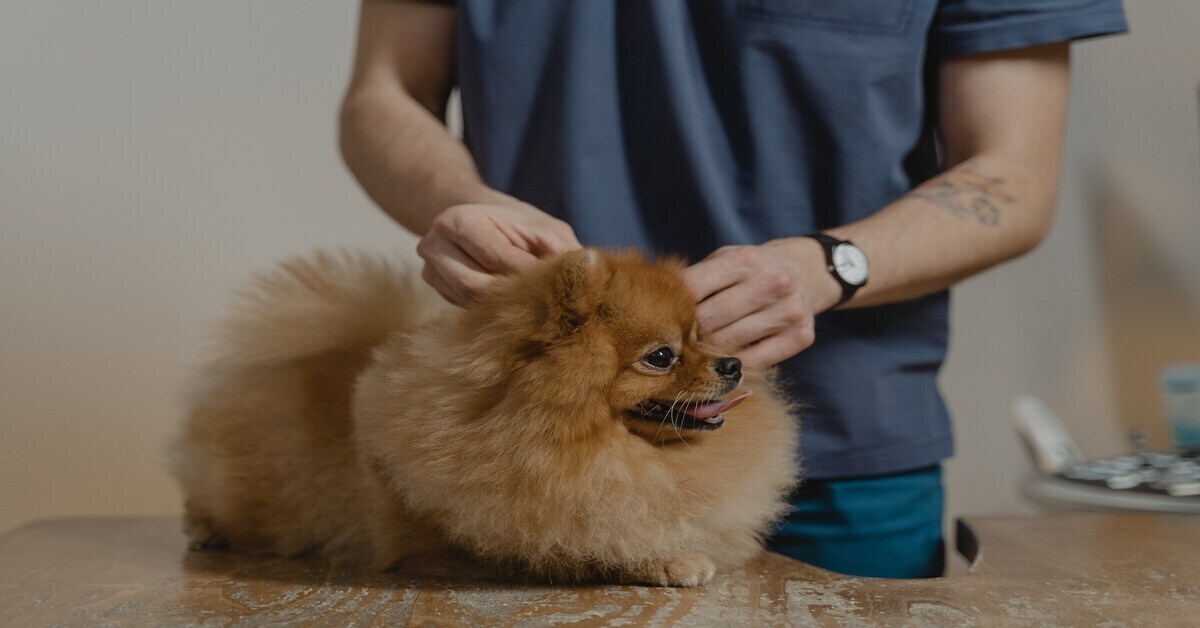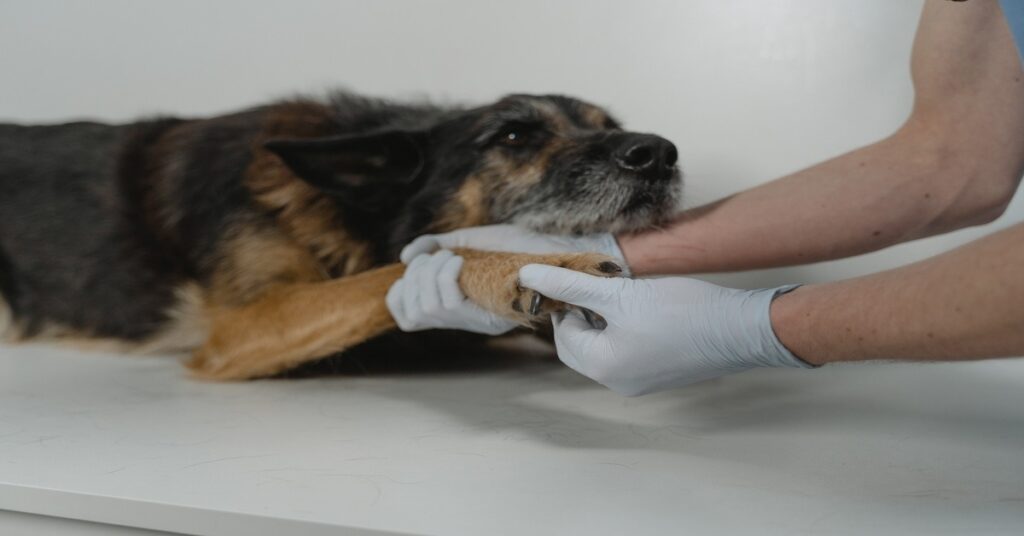As the weather warms up, you’re more likely to take your dog on outdoor adventures. While it’s a wonderful opportunity for your dog to get some exercise and enjoy some fresh air, ticks are also lurking in grassy areas, tall weeds, and other places where dogs like to explore. Fortunately, there are several ways to minimize exposure to ticks while still enjoying the outdoors with your dog. In this post, we will look at some tips on how to keep ticks off dogs. Let’s get started.
What are ticks?
Ticks are tiny arthropods that feed on blood from vertebrates, including humans and animals. They have eight legs with two-part bodies, chewing mouthparts and spinnerets for creating silk which helps them stay attached to the host they’ve chosen. One of their favorite hosts is dogs. Ticks are most active in humid environments, so they are common in grassy areas, tall weeds, and other places where dogs like to explore.
Related: Tips for camping with kids
Life Cycle of the Tick

Ticks are fascinating creatures. When they’re not feeding on blood, they spend most of their time in a dormant state called “diapause.” They emerge from diapause in extremely warm seasons when the weather is more humid. At this time, ticks search for hosts and feed on them to reproduce.
After mating, the female tick lays her eggs on vegetation or soil. She then dies. The eggs hatch into very small larvae that have to feed on a blood meal before they develop into nymphs. Larvae often molt several times as they grow, requiring more blood meals along the way.
Nymphs eventually become adults and mate in the same way as their parents. Female ticks attach themselves to hosts and then feed for several days until they’re engorged with blood. After feeding, they drop off the host, lay eggs, and die. Male ticks do not feed on blood but look for female mates until they die soon after mating.
How do ticks carry diseases?
Ticks are parasites that feed by latching onto mammals such as dogs, cats, humans, and livestock. They enjoy crawling into the fur of mammals because it makes them less detectable to predators. Ticks also enjoy the warm, moist environment around mammalian hosts. While feeding on blood, ticks can transmit Lyme disease, Rocky Mountain spotted fever and other illnesses. Different tick species carry different diseases, so it’s important to identify the type you’re dealing with.

A variety of ticks are found in North America. The American dog tick is extremely common throughout the United States and southeastern Canada. It feeds on dogs, cats and humans. The Lone Star tick is also common in the southeastern portions of the United States. It feeds on dogs, raccoons, small mammals, and other warm-blooded animals. Other types of ticks include Brown dog ticks, Deer ticks, and Blacklegged ticks (also known as deer or wood ticks). Of these, Deer ticks are the most common carrier of Lyme disease since they feed on deer.
In areas where there are a lot of deer, this tick species causes significant problems for pets and humans. The Blacklegged tick is found in wooded areas where its host (deer or other mammals) live. It also spreads Lyme disease and can infect other mammals as well.
How can I distinguish between ticks and other bugs?
Ticks are extremely small, but you should be able to spot them if they’re crawling on your dog’s fur. If the bug is brown, has eight legs, a two-part body, and is flat, it’s probably a tick.
Ticks are not furry, so it’s probably not a tick if the bug is covered with fur. Ticks also have mouthparts that can be seen when they open their mouths while feeding. This allows you to see how many parts the mouthparts are divided into. The mouthparts of ticks aren’t covered with spines either, so it isn’t a tick if the bug has spines on its underside.

How do I prevent my dog from getting ticks?
Ticks live in wooded areas and grassy fields where their favorite hosts live – deer, other mammals, and birds. If your dog spends a lot of time outside, he is likely to pick up ticks.
Use these helpful tips to keep ticks off dogs:
Frontline Plus
Use Frontline Plus or a similar product available at your veterinarian. No matter how much you love your dog, there are times when it’s easier to get rid of ticks than it is to keep them off your dog. These products contain an insecticide that kills ticks before they can stick onto the skin of your pet.
If you have already noticed some larvae in your dog’s fur, give him a flea bath. Use an insecticide dip for dogs to kill off the larvae and protect your pet from severe problems in the future.
Shave your dog
This method involves the use of chemicals, but it has been proven effective and easy to do. Shaving your dog is a great way to remove ticks, fleas, and parasites from your pet’s fur before they stuck onto the skin.

Bathe your dog
Do this regularly – once every one or two weeks. If you have extra time, it would be best if you were to shampoo your pet with a flea and tick shampoo once a month. This is an inexpensive way of killing fleas that have already bitten your dog.
If you don’t have the time or don’t want to bother using chemical shampoos, use vinegar as an alternative. A cup of vinegar in the final rinse water will kill ticks on dogs naturally. Be careful, however, not to let the dog ingest the vinegar as it may lead to issues like dehydration and diarrhea.
Sprays
Anti-tick sprays are also effective in keeping ticks away from your dog. It is recommended that you spray the chemical on the pet’s collar and body before taking him out in grassy or wooded areas.
Tips on how to keep ticks off dogs naturally
By keeping your dog groomed, you can eliminate the chances of ticks crawling up into their fur. This way, ticks will not get a chance to bite your pet. If you want to avoid using chemical sprays, you should first learn how to check your dog for ticks properly. Do it carefully and thoroughly so that you will not miss any ticks.

To keep ticks from moving around, it is best to go through the dog’s fur layer by layer so you can easily notice the ticks as they move. Remember to use your personal protection when checking for ticks on your dog. Wear disposable gloves to prevent ticks from crawling into your skin or clothes
Make your home tidy
You should also make sure to vacuum your house and yard frequently since this is a great way of getting rid of larvae left by ticks. This natural cleaning method works great for ticks on dogs and other parasites as well. Pay attention to furniture, carpets, bedding, and any other fabric where ticks can hide. Be sure to vacuum these areas at least once a week.
Related: How to prevent a bear attack while hiking
Check on pets that go out often
You should also look out for pets that spend a lot of time outdoors and bring them in regularly for check-ups. Find and remove ticks before the parasites can bite your dog. In addition, check other dogs in your household since they could be the carriers of ticks and fleas that have bitten your dog. If your dog is allergic to fleas and ticks, it would be best if you consider removing the tick before it has had a chance to bite him.
You should make sure that you check your dog closely for ticks before bringing it to grassy or wooded areas. This is a great way to keep ticks off dogs naturally. Do not forget to inspect the dog’s ears since ticks may crawl into them. It can be hard to remove a tick once it has gone in deep inside the ear canal.
Use Essential oils
If you are looking for a natural solution to get rid of ticks, consider using essential oils such as cedar or clove oil. Clove oil is suitable for tick infestations but must be used with caution since too much can irritate the skin. Cedar oil is better and safer than clove oil, especially if you have a sensitive pet. Clove and cedar oil can be mixed with carrier oil such as olive, sesame or almond, to make it more effective. Aromatherapy is also a good alternative. You can try using lavender or chamomile essential oils in the dog’s bed.

If you are looking for an all-natural way to protect your pet from ticks, consider using collars that emit organic compounds. This product can ward off any parasitic threat but must be used with caution since too much of it might cause skin irritation. It is best if you use a combination of methods to keep ticks off dogs naturally.
Symptoms of tick bite in dogs
The symptoms of tick bites in dogs may vary depending on the type of ticks. In general, they can include:
- Exercise – ticks make it hard for dogs to play well. They suck blood from dogs (usually their legs).
- Loss of energy and weight loss
- Shaking and shivering, usually from fever (from the immune system fighting off the foreign body)
- Hair loss or excessive grooming around one area (where a tick is lodged and feeding off the dog)
Recognizing symptoms of tick bites
Ticks are tiny creatures, but they can cause serious harm to your canine friend. The symptoms may appear for several days after the bite. You may be able to feel a lump on your dog if a large number of ticks have attached themselves to your pet’s skin. They also cause irritation and itching. The first sign that you can see is an area of hair loss on your dog, around where the tick has been feeding on.
However, it is important to note that most dogs carry ticks without attaching them to their skin because they are not easy to spot (they are so small). They only show up once they have fed from the dog for a few days. These ticks also prefer dark and moist areas of your dog’s body.
If your dog has ticks, you can treat them yourself. But if you suspect that your dog might have Lyme disease, this condition must be taken care of by an experienced vet immediately. If you miss it, the effects could be very harmful to your pet’s health in the long run. As much as possible, avoid exposing your dog to ticks.

More tips on how to keep ticks off dogs
♦ Keep your lawn clean from fallen leaves or debris. Dogs will easily hide in these places once they find a place to feed from. You can use a leaf blower to blow-dried leaves, pine straw, etc., and collect these debris in a trashcan or bag.
♦ Do not let your dog play outdoors for long periods. This gives them more chances to encounter ticks and get infected with diseases.
♦ Let your dog sleep indoors (in the garage or inside the house) because ticks like to hide under the fallen leaves.
♦ Avoid walking on tall grass and bushes because ticks are hidden there. Walk at the edge of the woods or in the open areas where it is easier to spot a tick before it attaches itself to your dog.
♦ Use flea-tick collars or sprays for dogs. These products usually contain all ingredients that prevent ticks from attaching themselves to your dog’s skin.
♦ Remove all ticks from your dog by carefully squeezing them with tweezers or burning them off using a matchstick. Do not use petroleum jelly or a lighted match to get rid of ticks. This will only release the toxins carried by the tick inside your dog’s body faster, making your pet sicker.
♦ Disinfect the area where you got rid of the ticks using antiseptic soap or any antiseptic product to avoid infections. You can also trim the fur or area of your dog where you got rid of a tick.
♦ Take proper precautions when using pesticides to prevent from coming into contact with areas that may be infected by ticks or insecticides if they are harmful to pets.
Buy medicine from legit stores
♦ Buy chemicals and medicines from reliable businesses (e.g., pet stores) because many fake products are not designed to be used on animals.
♦ Ask your vet for advice if you have any questions about your dog’s health care. They know more about the possible treatments based on your pet’s condition.
I hope the above tips on how to keep ticks off dogs will help protect your dog from these tiny critters. These simple solutions will also help you avoid the more complicated and expensive treatments for ticks. Have you ever dealt with ticks on dogs? Tell us about it in the comments section!

